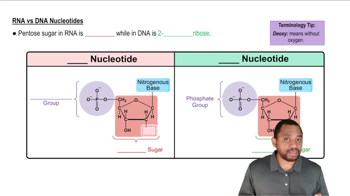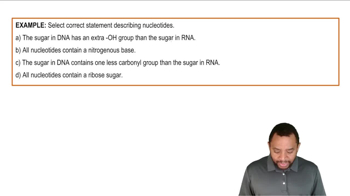Here are the essential concepts you must grasp in order to answer the question correctly.
Ribose
Ribose is a five-carbon sugar (pentose) that is a crucial component of RNA (ribonucleic acid). It has a hydroxyl group (-OH) attached to each of its carbon atoms, which makes it more reactive and versatile in biochemical processes. Ribose plays a key role in cellular metabolism and energy transfer, particularly in the form of ATP (adenosine triphosphate).
Recommended video:
Intro to Nucleic Acids Concept 2
Deoxyribose
Deoxyribose is also a five-carbon sugar, but it differs from ribose by lacking one oxygen atom; specifically, it has a hydrogen atom (-H) instead of a hydroxyl group (-OH) on the second carbon. This structural difference is significant as it contributes to the stability of DNA (deoxyribonucleic acid), making it less reactive than RNA. Deoxyribose is essential for the formation of the DNA backbone, which encodes genetic information.
Recommended video:
Nucleic Acids
Nucleic acids, including DNA and RNA, are biopolymers essential for all known forms of life. They are composed of nucleotide monomers, which include a sugar (ribose or deoxyribose), a phosphate group, and a nitrogenous base. The differences in sugar types (ribose in RNA and deoxyribose in DNA) influence the structure and function of these molecules, impacting processes such as protein synthesis and genetic inheritance.
Recommended video:
Intro to Nucleic Acids Concept 1
 Verified step by step guidance
Verified step by step guidance Verified Solution
Verified Solution



 1:55m
1:55m